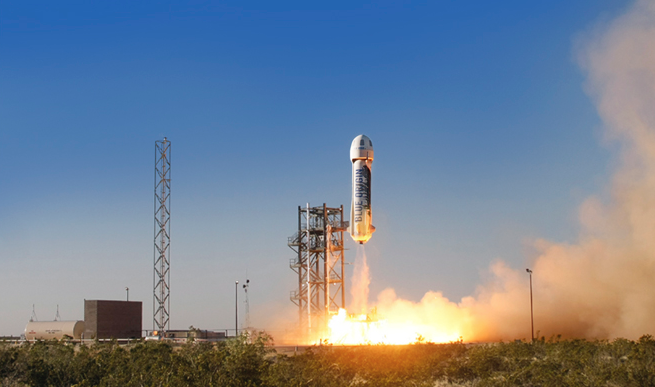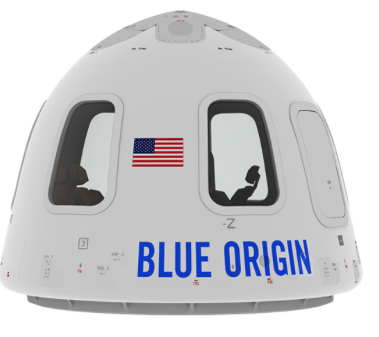
[SatNews] Those at Blue Origin are beginning to live their dreams with today's successful test flight of their reusable test space vehicle, New Shepard. Amazon's founder Jeff Bezos made the following statement.
"Today we flew the first developmental test flight of our New Shepard space vehicle. Our 110,000-lbf thrust liquid hydrogen, liquid oxygen BE-3 engine worked flawlessly, powering New Shepard through Mach 3 to its planned test altitude of 307,000 feet. Guidance, navigation and control was nominal throughout max Q and all of ascent. The in-space separation of the crew capsule from the propulsion module was perfect. Any astronauts on board would have had a very nice journey into space and a smooth return.
In fact, if New Shepard had been a traditional expendable vehicle, this would have been a flawless first test flight. Of course one of our goals is reusability, and unfortunately we didn’t get to recover the propulsion module because we lost pressure in our hydraulic system on descent. Fortunately, we’ve already been in work for some time on an improved hydraulic system. Also, assembly of propulsion module serial numbers 2 and 3 is already underway—we’ll be ready to fly again soon.

We continue to be big fans of the vertical takeoff, vertical landing architecture. We chose VTVL because it’s scalable to very large size. We’re already designing New Shepard’s sibling, her Very Big Brother—an orbital launch vehicle that is many times New Shepard’s size and is powered by our 550,000-lbf thrust liquefied natural gas, liquid oxygen BE-4 engine."
Blue Origin's goal is to offer commercial space flights. The capsules and rocket are completely new concepts.
The New Shepard capsule and booster are being designed and tested in a process that is both rigorous and disciplined. Their manufacturing and assembly technicians are experienced in aircraft and spacecraft manufacturing.
The elements of the New Shepard system are being tested extensively, both on the ground and during uncrewed test flights. From vibration tables and thermal chambers to hundreds of engine firings, these tests stress the vehicles and all of their subsystems.
Their flight test program continues to build experience with the New Shepard system in an uncrewed configuration, leading up to the day when they are ready for astronauts to climb on board for launch. Sitting atop a 60-foot-tall rocket in a capsule designed for six people, the passengers will feel the engine ignite and rumble under under them as it climbs through the atmosphere. Accelerating at more than 3 Gs to faster than Mach 3, you will count yourself as one of the few who have gone these speeds and crossed into space.

The New Shepard system is a fully reusable vertical takeoff, vertical landing (VTVL) space vehicle and consists of a pressurized capsule atop a booster. The combined vehicles launch vertically, accelerating for approximately two and a half minutes, before the engine cuts off. The capsule then separates from the booster to coast quietly into space. After a few minutes of free fall, the booster performs an autonomously controlled rocket-powered vertical landing, while the capsule lands softly under parachutes, both ready to be used again.
Reusability enabled Blue Origin to fly the system repeatedly. The New Shepard capsule’s interior is 530 cubic feet—offering over 10 times the room Alan Shepard had on his Mercury flight. It seats six astronauts and is large enough for it passengers to float freely and turn weightless somersaults. Each window is made of multiple layers of fracture-tough transparencies, designed to provide crystal clarity of the incredible views before you. Minimizing distortion and reflection, the windows transmit 92 percent of visible light—as good as glass.
The crew capsule descends under parachutes for a smooth landing, in the same way as the earliest space pioneers. Three independent parachutes provide redundancy, while a retro-thrust system further cushions the passengers' landing.
Today's test is the beginning of Bezos' dream being fulfilled.

